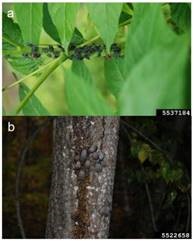Spotted Lanternfly Pest Information

(Photos: (a) Lawrence Barringer, (b) Pennsylvania Dept. of Agriculture)

Description
Adult Spotted Lanternflies are an inch long and ½ an inch wide at rest. The forewing is gray with black spots of varying sizes and the wing tips have black spots outlined in gray. Hind wings have contrasting patches of red and black with a white band. The legs and head are black, and the abdomen is yellow with black bands. Early instars (immature stages: 1st, 2nd, and 3rd instar) are black with white spots. By the last immature stage, the 4th instar, they develop red patches in addition to the black color with white spots. This is the last immature stage before they mature into an adult. Both the immature insect and the adult are quite visually striking. Adults are especially so when they have been startled and expose the bright red coloration on the hind wings. When the adult is at rest, particularly on the trunk of the tree of heaven, their gray, spotted color may actually cause them to blend in with their surroundings. Freshly laid egg masses appear as if coated with a white substance. As they age, the egg masses look as if they are coated with gray mud, which eventually takes on a dry/cracked appearance. Very old egg masses may look like rows of 30-50 brown seed-like structures aligned vertically in columns. Coated egg masses may look like "weird spongy moth egg masses", an insect also spreading in the Eastern United States and subject to quarantine by California.
(adapted from the UMass Spotted Lanternfly Fact Sheet)
History and Distribution
The Spotted Lanternfly is native to the southern part of China and other subtropical regions of southeast Asia. It was not known to be invasive until it spread to Korea in 2006 and to Pennsylvania in 2014. The Spotted Lanternfly has not been found in California, but it has been intercepted in airplanes from the eastern United States.
- Current Known North American Distribution (Map)
- Current Known North American Distribution (US State list)
Host Range
Spotted lanternfly is reported to feed on at least 103 species of plants (mostly trees) in 33 families. The immatures (nymphs) are much more polyphagous that the adults, which strongly prefer tree of heaven (Ailanthus altissima) and grape (Vitis species). Other hosts of nymphs and adults include Acer spp. (maples), Betula spp. (birches), Carya spp. (hickory), Fagus spp. (beech), Fraxinus spp. (ash), Malus domestica (apple), Prunus spp. (stone fruit), Quercus spp. (oaks), and Salix spp. (willows). There may be plants in California that are not yet known to be pests but only because we have not yet seen if the pest will feed on them.
Life Cycle
The spotted lanternfly has one generation per year and overwinters as eggs in an ootheca. In Pennsylvania, eggs start to hatch in April or May and nymphs begin sucking sap from young stems and leaves. Nymphs do not fly and are particularly polyphagous, feeding on a much wider variety of plants than adults. Their feeding produces large quantities of fluid, referred to as honeydew, that covers stems and leaves. The feeding weakens the plant, and the sooty mold that grows on the honeydew decreases photosynthesis, which may have a greater impact on the plant than the feeding itself. Infestations can weaken plants and eventually kill them. Adult spotted lanternfly can fly earlier in the season before they start to lay eggs. By September, many of the adults have moved to preferred hosts, if they are available. The strongly preferred host for adult feeding is tree of heaven (Ailanthus altissima) but they also prefer grape (Vitis spp.). Spotted lanternfly oothecae are deposited on trees (especially those with smooth bark) as well as a wide variety of outdoor objects, natural and manmade, including vehicles, stone, outdoor furniture, and storage containers. The most likely pathway for long-distance spread of this pest is the movement of oothecae on such objects or infested nursery stock.
Damage to Agriculture and Environment
Infestations of Spotted Lanternfly may lower crop yields and increase production costs in economically important crops such as grape, stone fruit, and nursery stock. Since it entered Korea, the insect has caused considerable damage in vineyards. The fairly recent incursion of this pest in agricultural commodities may cause trade disruptions due to its limited range in North America. The effects of Spotted Lanternfly on biodiversity in its introduced are not yet known. Although it currently is not known to disrupt natural communities or change ecosystem processes, its broad host range does present the possibility of future impacts on the natural environment. It may trigger new treatments in vineyards and stone fruit orchards and by residents who find infested plants unsightly. Spotted lanternfly may also significantly affect home/urban gardening by feeding on grapes and trees.
Fact Sheets
- Spotted Lanternfly Fact Sheet
- USDA APHIS | Spotted Lanternfly
- Ad Hoc Science Advisory Panel Responses
- CDFA Spotted Lanternfly Action Plan
